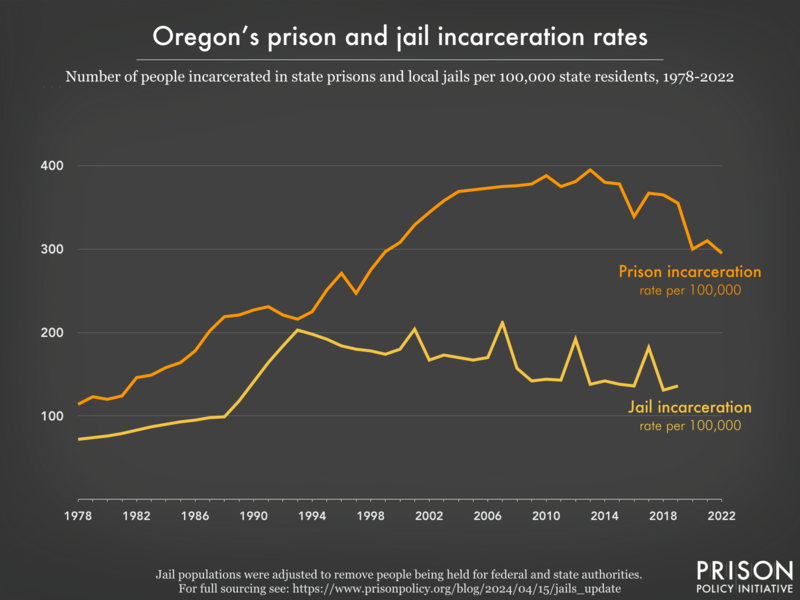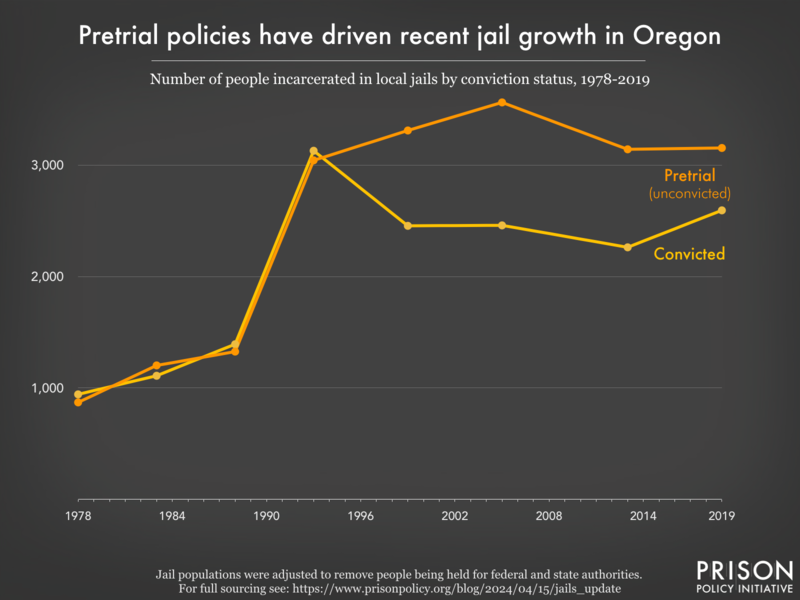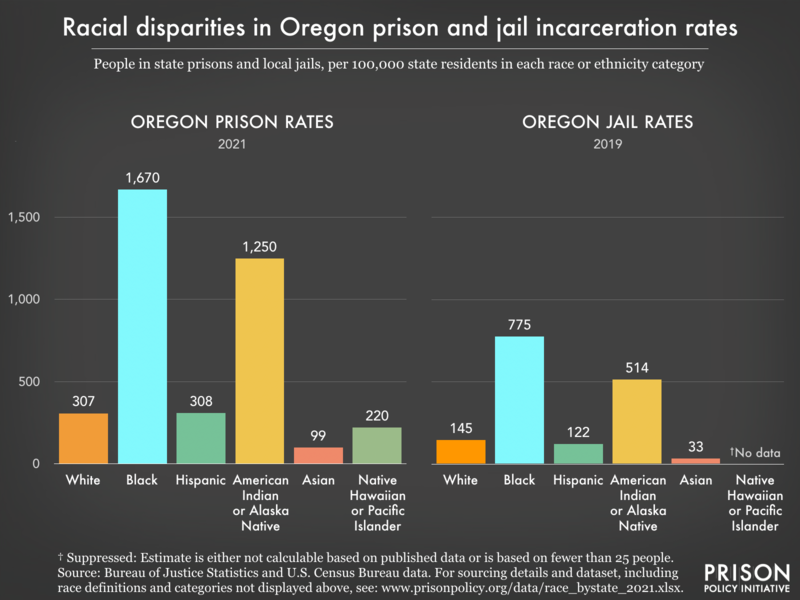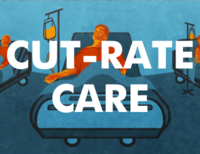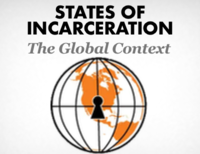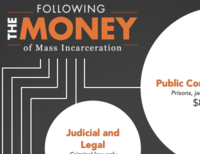Oregon profile
Oregon has an incarceration rate of 494 per 100,000 people (including prisons, jails, immigration detention, and juvenile justice facilities), meaning that it locks up a higher percentage of its people than almost any democratic country on earth. Read on to learn more about who is incarcerated in Oregon and why.
22,000 people from Oregon are behind bars
Additionally, the number of people impacted by county and city jails in Oregon is much larger than the graph above would suggest, because people cycle through local jails relatively quickly. Each year, at least 42,000 different people are booked into local jails in Oregon.
Rates of imprisonment have grown dramatically in the last 40 years
- total numbers rather than rates.
- Women’s prisons: Incarceration Rates | Total Population
- Men’s prisons: Incarceration Rates | Total Population
Today, Oregon’s incarceration rates stand out internationally

People of color are overrepresented in prisons and jails
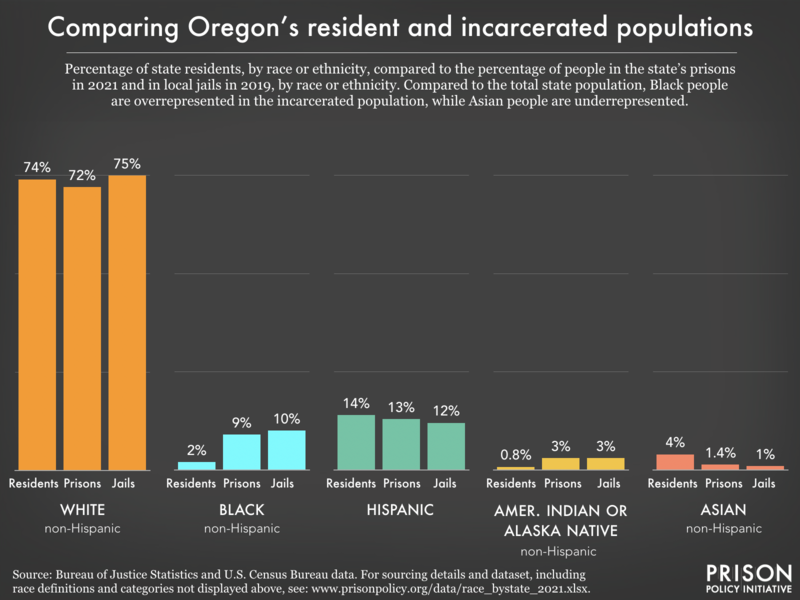
Oregon's criminal justice system is more than just its prisons and jails
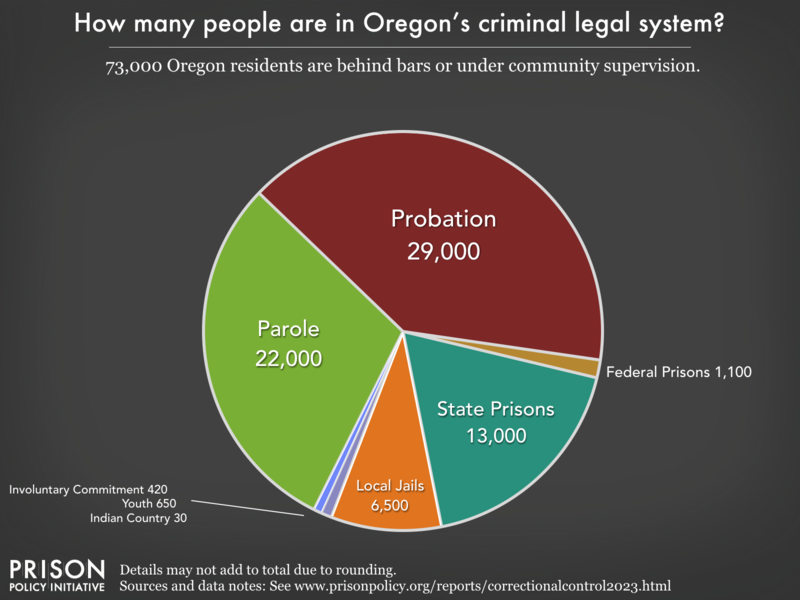
Reports and briefings about Oregon's criminal legal system:
Filter to show
- Oregon makes medications for opioid use disorder available in some of its prisons. Why is getting treatment for substance use disorders so difficult across the US carceral system?
- Oregon decreased its prison population during the pandemic and continued to cut its prison population between 2021 and 2023.
- People on probation in Oregon are saddled with onerous rules and conditions they must follow every day or risk incarceration.
- With an incarceration rate of 494 per 100,000 residents, Oregon locks up a higher percentage of its people than almost any democratic country on earth.
- Prisons in Oregon force incarcerated people and their families — some of the most vulnerable members of society — to subsidize mass incarceration.
- 55% of people in Oregon jails have not been convicted of a crime, meaning they're legally innocent. There are simple steps the state can take to reduce this number. Why isn't it?
- Oregon releases roughly 143,640 men and 45,181 women from its prisons and jails each year. What is it doing to support them upon reentry?
- Oregon shouldn’t go backwards on drug decriminalization
- In Oregon prisons, breaking certain rules can come with fines of $25-$200 that take months of work to pay off
- Black people in Oregon are incarcerated at a rate 5.4 times higher than white people.
- Oregon's choice to criminalize "failure to appear" may be hurting public safety
- The cost of incarcerating older people is incredibly high, and their risk of reincarceration is incredibly low, yet 15% of people in Oregon prisons are over the age of 55. Why is the state keeping so many older people locked up?
- During a recent heatwave, a prison in Oregon sold “cooling” towels for the outrageous price of $18
- Oregon makes it difficult or even risky for incarcerated journalists to tell their stories.
- In Oregon, 22,000 people are incarcerated and another 51,000 are on probation or parole.
- Oregon charges up to 25¢ for an e-message to or from prison.
- Oregon passed a pilot caregiver mitigation and diversion law that expands the use of sentencing alternatives to incarceration for primary caregivers.
- Jails in Oregon charge up to $3.15 for a 15-minute phone call, reaping profits for companies, while prisons charge $1.05 for a 15-minute call.
- Oregon is one of a handful of states that does not charge medical copays except for vision related and elective procedures.
- People in Oregon prisons must pay for hygiene items and other basics — regardless of their ability to pay. Someone who is considered indigent can get support with legal supplies, but they must pay the state back for any assistance they get.
- Oregon prisons charge families up to a 30% fee to transfer money to an incarcerated loved one.
- We gave Oregon a failing grade in September 2021 for its response to the coronavirus in prisons.
- Oregon hinders jury diversity by excluding people with felony records and some prior misdemeanors
- How many COVID-19 cases in Oregon communities can be linked to outbreaks in correctional facilities? (data from our report Mass Incarceration, COVID-19, and Community Spread)
- We graded the parole release systems of all 50 states - Oregon gets an F-
- Oregon incarcerates women at a rate of 130 per 100,000 residents — higher than almost any democratic country on earth.
- People in Oregon prisons earn as little as 5¢ an hour for their work.
- Victory: Multnomah County Sheriff reverses ban on in-person visits in Portland jails
Other resources
- Research on Oregon in our Research Library
- Ending prison gerrymandering in Oregon campaign and resource page

